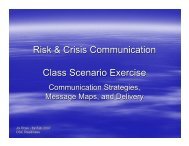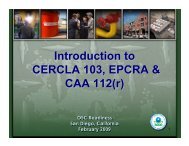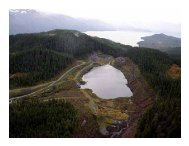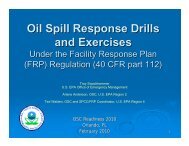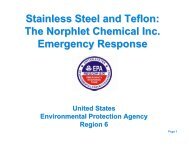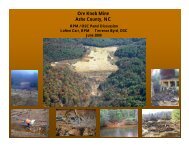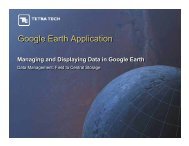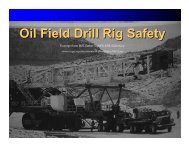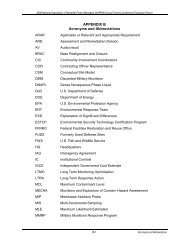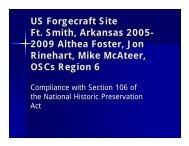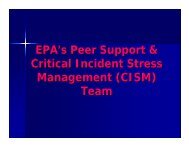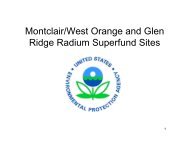Leeson NARPM SERDP ESTCP Info Session June 2009_hs.pdf
Leeson NARPM SERDP ESTCP Info Session June 2009_hs.pdf
Leeson NARPM SERDP ESTCP Info Session June 2009_hs.pdf
- No tags were found...
You also want an ePaper? Increase the reach of your titles
YUMPU automatically turns print PDFs into web optimized ePapers that Google loves.
Agenda10:15 AM10:20 AM10:30 AM11:15 AM11:30 AMWelcome and IntroductionWho we areWhat we offerInput into the development of research needsFunding for research or demonstrationsInnovative technologies & tools<strong>Info</strong>rmation on ITRCGeneral Discussion and Concluding RemarksAndrea <strong>Leeson</strong>Andrea <strong>Leeson</strong>Andrea <strong>Leeson</strong>Anna WillettAndrea <strong>Leeson</strong>19th Annual <strong>NARPM</strong> Training Conference • <strong>June</strong> 2-5, <strong>2009</strong> • Atlanta, Georgia 2
Materials ProvidedAgendaShort Course PresentationGeneral <strong>SERDP</strong>/<strong>ESTCP</strong> <strong>Info</strong>rmationExecutive Summaries from Expert Panel Workshops<strong>SERDP</strong> & <strong>ESTCP</strong> Solicitation ProcessFY10 <strong>SERDP</strong> Environmental Restoration SONsFY10 <strong>ESTCP</strong> Topic AreasFact sheet for ER-0916Research Area Fact SheetsDNAPL FAQs<strong>Info</strong>rmation Sheet & Order Form for In Situ Bioremediation of PerchlorateBioavailability Workshop ReportMNR Document<strong>SERDP</strong>/<strong>ESTCP</strong> Symposium fact sheetListserve sign up sheet19th Annual <strong>NARPM</strong> Training Conference • <strong>June</strong> 2-5, <strong>2009</strong> • Atlanta, Georgia 3
Environmental Drivers:Sustainability of Ranges and Range OperationsMaritime SustainabilityThreatened and Endangered SpeciesToxic Air Emissions and DustUnexplodedOrdnanceNoise NOX and PMUrban Growth& Encroachment19th Annual <strong>NARPM</strong> Training Conference • <strong>June</strong> 2-5, <strong>2009</strong> • Atlanta, Georgia 6
Environmental Drivers:Reduction of Current and Future LiabilityCurrent LiabilitiesFuture LiabilitiesContamination from Past Practices• Chlorinated Solvents• UXO• Emerging Contaminants (Perchlorate)Control Life Cycle Costs• Elimination of Hazardous Materials• Achieve Compliance ThroughPollution Prevention19th Annual <strong>NARPM</strong> Training Conference • <strong>June</strong> 2-5, <strong>2009</strong> • Atlanta, Georgia 7
<strong>SERDP</strong> and <strong>ESTCP</strong> PillarsSustainableInfrastructureMunitionsManagementEnvironmentalRestorationWeapon / PlatformManagementContaminatedSoilsManufacture &MaintenanceContaminatedWaterGreenEnergeticsNaturalResourceManagementUXORemediationContaminatedSedimentsEmissionsFacilitiesManagementRangeClearanceEffects19th Annual <strong>NARPM</strong> Training Conference • <strong>June</strong> 2-5, <strong>2009</strong> • Atlanta, Georgia 9
Environmental Restoration ProgramCharacteristics ~200 active projects Projects range from $85K to 2.5M/year, averagesize is $400K/year 95% of projects are partnered Project length runs 1 to 5 years Turn over roughly 25% of the program each year19th Annual <strong>NARPM</strong> Training Conference • <strong>June</strong> 2-5, <strong>2009</strong> • Atlanta, Georgia 10
<strong>SERDP</strong> Funding807570$ M656055504540FY08 FY09 FY10 FY11 FY12 FY13= Congressional Adds19th Annual <strong>NARPM</strong> Training Conference • <strong>June</strong> 2-5, <strong>2009</strong> • Atlanta, Georgia 11
<strong>SERDP</strong> FY <strong>2009</strong> FundingSBIR etc.6%ProgramOffice11%SustainableInfrastructure24%MunitionsManagement16%EnvironmentalRestoration25%$69.0 million158 ProjectsWeapons Systemsand Platforms22%19th Annual <strong>NARPM</strong> Training Conference • <strong>June</strong> 2-5, <strong>2009</strong> • Atlanta, Georgia 12
<strong>ESTCP</strong> Funding$ M50454035302520151050FY08 FY09 FY10 FY11 FY12 FY13= Congressional adds19th Annual <strong>NARPM</strong> Training Conference • <strong>June</strong> 2-5, <strong>2009</strong> • Atlanta, Georgia 13
<strong>ESTCP</strong> FY <strong>2009</strong> Core FundingWeapons Systemsand Platforms22%SustainableInfrastructure18%MunitionsManagement22%EnvironmentalRestoration29%$31.6 million122 ProjectsProgramOffice6%SBIR etc.3%19th Annual <strong>NARPM</strong> Training Conference • <strong>June</strong> 2-5, <strong>2009</strong> • Atlanta, Georgia 14
Agenda10:15 AM10:20 AM10:30 AM11:15 AM11:30 AMWelcome and IntroductionWho we areWhat we offerInput into the development of research needsFunding for research or demonstrationsInnovative technologies & tools<strong>Info</strong>rmation on ITRCGeneral Discussion and Concluding RemarksAndrea <strong>Leeson</strong>Andrea <strong>Leeson</strong>Andrea <strong>Leeson</strong>Anna WillettAndrea <strong>Leeson</strong>19th Annual <strong>NARPM</strong> Training Conference • <strong>June</strong> 2-5, <strong>2009</strong> • Atlanta, Georgia 15
What we offer:Input into the development of research needsAgency Coordination ProcessServices’Requirements<strong>SERDP</strong>/<strong>ESTCP</strong> Committees•• Army•• Navy•• Air Air Force•• DOE•• EPA EPAStatementsOf Of NeedOpenSolicitationR&DProposalsFundedProjects19th Annual <strong>NARPM</strong> Training Conference • <strong>June</strong> 2-5, <strong>2009</strong> • Atlanta, Georgia 16
Review Committee Responsibilities Assist with research need identification Review and select solicited proposals for funding Review ongoing projects for technical quality andcoordination with efforts in their own agency Assist with tech transfer within their own agency19th Annual <strong>NARPM</strong> Training Conference • <strong>June</strong> 2-5, <strong>2009</strong> • Atlanta, Georgia 17
<strong>SERDP</strong> Statement of Need Identification Workshops Topics for workshops generally identified from reviewcommittee input Examine the current state of science and engineering Identify the gaps in knowledge and technology Prioritize those gaps where investments in research anddevelopment or field demonstrations could have thegreatest impact Input from Services Review of past SONs or completing projects General knowledge of field19th Annual <strong>NARPM</strong> Training Conference • <strong>June</strong> 2-5, <strong>2009</strong> • Atlanta, Georgia 18
Recent Workshops All workshops composed of ~40-80 experts in thefield from academia, government & industry Recent workshops include: Bioavailability in Soil & Sediments (August 2008) Range Assessment (August 2007) DNAPL (March 2006) Molecular Biological Tools (August 2005) Sediments (August 2004) A summary report is prepared from each workshopand is used to guide research investment over nextfive years19th Annual <strong>NARPM</strong> Training Conference • <strong>June</strong> 2-5, <strong>2009</strong> • Atlanta, Georgia 19
Agenda10:15 AM10:20 AM10:30 AM11:15 AM11:30 AMWelcome and IntroductionWho we areWhat we offerInput into the development of research needsFunding for research or demonstrationsInnovative technologies & tools<strong>Info</strong>rmation on ITRCGeneral Discussion and Concluding RemarksAndrea <strong>Leeson</strong>Andrea <strong>Leeson</strong>Andrea <strong>Leeson</strong>Anna WillettAndrea <strong>Leeson</strong>19th Annual <strong>NARPM</strong> Training Conference • <strong>June</strong> 2-5, <strong>2009</strong> • Atlanta, Georgia 20
BAA Call CallReviewCommitteeDevelopSONs<strong>SERDP</strong> Solicitation ProcessPreproposalNovember each yearStaff ReviewFull Full ProposalPrivate Sector BAAPeer ReviewEWG Call CallFull Full ProposalFederal SectorReview & Program DevelopmentSAB ReviewEWG ApprovalCouncil Approval19th Annual <strong>NARPM</strong> Training Conference • <strong>June</strong> 2-5, <strong>2009</strong> • Atlanta, Georgia 21
FY10 <strong>SERDP</strong> Solicitation Environmental Restoration Sediment bioavailability (workshop output) Soil bioavailability (workshop output) Fate and transport prediction methods for military uniquecompounds Impact of Contaminant Storage in Low-PermeabilityZones on Chlorinated Solvent Groundwater Plumes19th Annual <strong>NARPM</strong> Training Conference • <strong>June</strong> 2-5, <strong>2009</strong> • Atlanta, Georgia 22
<strong>ESTCP</strong> Topic IdentificationTopic areas much broader under <strong>ESTCP</strong> than <strong>SERDP</strong>DoD topic areas have remained the same over the past several yearsCleanup (Remediation, Site Characterization, Site Monitoring)Unexploded Ordnance (Site Characterization, Remediation, CuedIdentification)Pollution Prevention (Material Substitution, Alternative Maintenance,Alternative Manufacturing, Recycling/Reuse)Compliance (Emission Monitoring, Emission Control, Waste Disposal, NoiseCompliance, Range and Installation Management)19th Annual <strong>NARPM</strong> Training Conference • <strong>June</strong> 2-5, <strong>2009</strong> • Atlanta, Georgia 24
FY10 <strong>ESTCP</strong> Solicitation Topic Areas: Remediation of Contaminated Groundwater In Situ Management of Contaminated Sediments Characterization, Control, and Treatment of RangeContamination Military Munitions Detection, Discrimination, andRemediation Energy Efficiency and Renewable Energy for DoDInstallations19th Annual <strong>NARPM</strong> Training Conference • <strong>June</strong> 2-5, <strong>2009</strong> • Atlanta, Georgia 25
FY09 <strong>ESTCP</strong> New Start Project Validation of an In Vitro Bioaccessibility TestMethod for Estimation of Bioavailability of Arsenic inSoil and Sediment Susan Griffin, Ph.D. (EPA Region 8) Objectives: Develop in vitro bioaccessibility assay for arsenic in soil& sediments and validate against 41 different testmaterials that have been tested previously forbioavailability in in vivo cynomolgus monkey or juvenileswine tests. Develop training regarding in vitro methods for assessingrelative oral bioavailability of arsenic on a site specificbasis19th Annual <strong>NARPM</strong> Training Conference • <strong>June</strong> 2-5, <strong>2009</strong> • Atlanta, Georgia 26
Agenda10:15 AM10:20 AM10:30 AM11:15 AM11:30 AMWelcome and IntroductionWho we areWhat we offerInput into the development of research needsFunding for research or demonstrationsInnovative technologies & tools<strong>Info</strong>rmation on ITRCGeneral Discussion and Concluding RemarksAndrea <strong>Leeson</strong>Andrea <strong>Leeson</strong>Andrea <strong>Leeson</strong>Anna WillettAndrea <strong>Leeson</strong>19th Annual <strong>NARPM</strong> Training Conference • <strong>June</strong> 2-5, <strong>2009</strong> • Atlanta, Georgia 27
Environmental Restoration Research Focus Areas Chlorinated Solvents Dissolved Phase DNAPL Source Zones Munitions Constituents Perchlorate Energetics Heavy Metals Sediments Risk Assessment Site Characterization andMonitoring Performance Assessment& Optimization19th Annual <strong>NARPM</strong> Training Conference • <strong>June</strong> 2-5, <strong>2009</strong> • Atlanta, Georgia 28
19th Annual <strong>NARPM</strong> Training Conference • <strong>June</strong> 2-5, <strong>2009</strong> • Atlanta, Georgia 29
19th Annual <strong>NARPM</strong> Training Conference • <strong>June</strong> 2-5, <strong>2009</strong> • Atlanta, Georgia 30
19th Annual <strong>NARPM</strong> Training Conference • <strong>June</strong> 2-5, <strong>2009</strong> • Atlanta, Georgia 31
19th Annual <strong>NARPM</strong> Training Conference • <strong>June</strong> 2-5, <strong>2009</strong> • Atlanta, Georgia 32
Chlorinated Solvent WorkshopChlorinated Solvent Research &Demonstration Efforts in <strong>SERDP</strong>/<strong>ESTCP</strong>Passive TreatmentTechnologiesS&TAnaerobic/AerobicBiodegradation of cis-DCE/VCLong-Term Sustainabilityof MNAAbiotic Processescis-DCE/VC DegradationMechanisms &Environmental RelevanceLarge, DilutePlumesDem/ValPassive Treatment Technologies (FY96)Enhanced Biological Technologies (FY97)Physical/Chemical Technologies (FY98)FY99 FY00 FY01 FY03 FY04 FY06FY07FY08Long-Term Sustainabilityof MNAFY0919th Annual <strong>NARPM</strong> Training Conference • <strong>June</strong> 2-5, <strong>2009</strong> • Atlanta, Georgia 33
SELECTED TOPICSOverview(McCarty)Abiotic Processes (Cwiertny, Scherer)Biodegradation (Chapelle, Bradley)Engineering Challenges (Simpkin, Norris)Modeling(Rifai, Borden, Newell, Bedient)Source Treatment (Sale)Characterization (Mercer, Cohen, Noel)Chemical Treatment (Brown)Phytoremediation (van Aken, Geiger)MNA(Wilson)Air Sparging(Johnson, Johnson, Bruce)Barrier Walls(Gillham, Vogan et al.)Electrolytic Walls (Gilbert, Sale, Peterson)In-Well Treatment (Alleman)Biostimulation(Henry)Bioaugmentation (Stroo, Major, Gossett)19th Annual <strong>NARPM</strong> Training Conference • <strong>June</strong> 2-5, <strong>2009</strong> • Atlanta, Cost Analysis Georgia (Harkness, Farnum) 34
Verification of Methods for Assessing theSustainability of Monitored Natural AttenuationLead Investigators:Carmen Lebrón, NAVFAC ESCMark Widdowson, Ph.D., Virginia TechFrank Chapelle, Ph.D., USGSJack Parker, Ph.D., University of TennesseeObjectives:To dem/val an integrated methodology for assessing long-term sustainability of MNAwhich captures the full range of NA processes (diminishing source mass flux, dilutionand dispersion, biological and abiotic transformations, volatilization, andevapotranspiration).• Validate a methodology for calculating bioavailable organic carbon (BOC) by establishingcorrelations with field-measured dissolved oxygen (DO) and chloroethene concentrations,concentrations of natural organic carbon compounds present in aquifer sediment, and rateand extent of reductive dechlorination;• Verify upscaled source zone depletion (SZD) function using site contaminant concentrationdata for a range of source zone geometries• Validate short term sustainability using BOC and DO concentration data and demonstrate longterm sustainability of MNA using SEAM3D v.2.1 at four sites where time of remediation isestimated using the SZD function. Product: framework & methods as well as an interactive computational tool toassess the long-term sustainability of MNA-based remediation strategies. Estimated completion: late 201019th Annual <strong>NARPM</strong> Training Conference • <strong>June</strong> 2-5, <strong>2009</strong> • Atlanta, Georgia 35
Chlorinated Solvents WorkshopDNAPL WorkshopEnhanced Source Removal (FY94 Start)Detection (FY97 Start)ISCODistribution ofAmendmentsS&TImpacts of TreatmentCharacterization & DelineationDiagnostic ProceduresThermal TreatmentFractured RockFlushing (FY97 Start)Biological TreatmentDem/ValCharacterization & DelineationMonitoring and AssessmentThermal TreatmentCombined ApproachISCOFY00FY01FY02 FY03 FY04 FY05 FY06FY07 FY08 FY0919th Annual <strong>NARPM</strong> Training Conference • <strong>June</strong> 2-5, <strong>2009</strong> • Atlanta, Georgia 36
Ongoing Initiatives Related to DNAPL SourceZones Understanding Sources & Plume Response Fractured Rock Site Remediation In Situ Thermal Treatment In Situ Chemical Oxidation Nanoscale Iron In Situ Bioremediation Site Characterization and Monitoring Technology Performance Evaluation & Prediction19th Annual <strong>NARPM</strong> Training Conference • <strong>June</strong> 2-5, <strong>2009</strong> • Atlanta, Georgia 37
R&D Needs: 2006 WorkshopBetter Understanding of Plume ResponseHow To Treat the “Advectively Challenged”Vapor Transport From SourcesHow to Remediate Karst & Complex Sites19th Annual <strong>NARPM</strong> Training Conference • <strong>June</strong> 2-5, <strong>2009</strong> • Atlanta, Georgia 38
<strong>SERDP</strong> DNAPL Initiative Goals Help managers make best-informed decisions possible Improve predictive capabilities, decision support, andfundamental understanding Help develop and validate innovative technologies toimprove DNAPL treatment Primary drivers: Reduce life-cycle costs Meet schedules for remedies-in-place Use limited resources wisely NOT to promote any technology or any agenda to treat or nottreat sources19th Annual <strong>NARPM</strong> Training Conference • <strong>June</strong> 2-5, <strong>2009</strong> • Atlanta, Georgia 39
Progress1. Assess Source Zone Treatment Technologies Large-tank tests of ISCO, bio, and thermal Field-scale tests of ISCO, bio, and thermal Develop and test ISCR and combined technologies Models of performance and uncertainty Data mining to document costs and performance Testing in fractured media19th Annual <strong>NARPM</strong> Training Conference • <strong>June</strong> 2-5, <strong>2009</strong> • Atlanta, Georgia 40
Progress2. Quantify Benefits of Source Depletion Laboratory and field assessments of flux beforeand after treatments Flux measurements after full-scale treatment Experimental and modeling assessments ofsource depletion benefits19th Annual <strong>NARPM</strong> Training Conference • <strong>June</strong> 2-5, <strong>2009</strong> • Atlanta, Georgia 41
Progress3. Improve Delivery Nanoscale iron delivery Partitioning electron donors Mobility control methods to enhance sweepefficiency19th Annual <strong>NARPM</strong> Training Conference • <strong>June</strong> 2-5, <strong>2009</strong> • Atlanta, Georgia 42
Progress4. Improve Decision Support Remedy Selection Guidance Optimizing DNAPL source and plumeremediation Estimating cleanup times DNAPL Remediation Screening Tool Diagnostic tools19th Annual <strong>NARPM</strong> Training Conference • <strong>June</strong> 2-5, <strong>2009</strong> • Atlanta, Georgia 43
Key Concepts Mass Flux Can Improve Decision-Making To select, design & assess remediation Understand Mass Storage CompartmentsVarying responses to remediation approachesPlume characteristics affect source management decisions Set Realistic Goals90-99.99% source removal, 90-99% plume decrease1st order rate of restoration – long “tail” Uncertainty is Inevitable Apply the observational approach “Remedy Packages” Are Needed Functional objectives for each element19th Annual <strong>NARPM</strong> Training Conference • <strong>June</strong> 2-5, <strong>2009</strong> • Atlanta, Georgia 44
Half Full or Half Empty?The hydraulic balance1. Technology has made impressive advances A suite of demonstrated technologies and combinations MCLs are achievable in some cases We can significantly decrease plume extent, longevity,and liability2. There are serious “practicable” limits Given unlimited resources, we could clean up all DNAPLsites Resources are limited Uncertainty is highWhen do benefits justify costs?19th Annual <strong>NARPM</strong> Training Conference • <strong>June</strong> 2-5, <strong>2009</strong> • Atlanta, Georgia 45
You Gotta Know Your Limits“Trust your passions less,your reasons more,and your limits most”Daniel Robinson, Oxford UniversityFrom NPR Interview:"The Philosophy of ChoosingBetween Bad Options"19th Annual <strong>NARPM</strong> Training Conference • <strong>June</strong> 2-5, <strong>2009</strong> • Atlanta, Georgia 46
Available Products47
FAQs – a one hour read AudienceParties participating in theprocess of selectingremedies for chlorinatedsolvent releases Provides quick access tokey concepts & references19th Annual <strong>NARPM</strong> Training Conference • <strong>June</strong> 2-5, <strong>2009</strong> • Atlanta, Georgia 48
Decision Guide – The Longer AnswerGuide for Selecting Remedies forSubsurface Releases of ChlorinatedSolvents (Sale, Newell, Stroo,Hinchee, Johnson)What it isHighlights new developments resite specific conditions, developingattainable & beneficial goals,selecting technologies, &packaging site remedies.Knowledge bridge to practitionersThings to think about - Rules ofthumb, Lessons learned...Small phone bookRoute for those want moreFinal document available late<strong>2009</strong>After NRC (2005)19th Annual <strong>NARPM</strong> Training Conference • <strong>June</strong> 2-5, <strong>2009</strong> • Atlanta, Georgia 49
DNAPL-Test: A Screening Tool for SelectingDNAPL Remediation Technologies C. Lebrόn, B. Kueper, J. Konzuk ObjectivesReduce uncertainty in estimating remedial outcomesEvaluate potential technology performanceAid RPMs in technology selection based on desiredperformance metrics Available late <strong>2009</strong>19th Annual <strong>NARPM</strong> Training Conference • <strong>June</strong> 2-5, <strong>2009</strong> • Atlanta, Georgia 50
Thermal Treatment Design Tool Develop tool to anticipatelikely design &performance of thermalbasedDNAPL treatment. Link design & performanceexperience to smallnumber of generalized sitescenarios. Evaluate improvements ingroundwater quality &reductions in massdischarge (flux). Available mid-<strong>2009</strong>From Reuther and Greenwell, 200219th Annual <strong>NARPM</strong> Training Conference • <strong>June</strong> 2-5, <strong>2009</strong> • Atlanta, Georgia 51
Amendment Injection Toolkitwww.estcp.org/_cs_upload/ER-0626-ToolKit19th Annual <strong>NARPM</strong> Training Conference • <strong>June</strong> 2-5, <strong>2009</strong> • Atlanta, Georgia 52
In Situ Chemical Oxidation: TechnologyPractice Manual Robert Siegrist and Michelle Crimi Develop a design protocol and decision tools ISCO cost and performance database Customized searches for specific site conditions FAQ Guide Testing design protocol at DoD sites Training available now Final document available late <strong>2009</strong>19th Annual <strong>NARPM</strong> Training Conference • <strong>June</strong> 2-5, <strong>2009</strong> • Atlanta, Georgia 53
Mass Flux Toolkit Developed by GSIEnvironmental Inc. Easy-to-use, Microsoft®Excel-based software tool Learn about different massflux approaches, calculatemass flux from transectdata, & apply mass fluxvalues to managegroundwater plumes• Available now19th Annual <strong>NARPM</strong> Training Conference • <strong>June</strong> 2-5, <strong>2009</strong> • Atlanta, Georgia 54
Sediments WorkshopER Strategy WorkshopDNAPL WorkshopLTM SEEDLong-Term MonitoringResearch & Demonstration Effortsin <strong>SERDP</strong>/<strong>ESTCP</strong>S&TLTM SEED: AlternativeTechnologiesLTM: Improved Methods AndPracticesImpact of EnvironmentalParameters/SamplingMethods on MeasuredConcentrationsDem/ValLow cost wells/samplingPassive samplerFY00 FY01 FY03 FY04 FY06 FY07 FY08 FY0919th Annual <strong>NARPM</strong> Training Conference • <strong>June</strong> 2-5, <strong>2009</strong> • Atlanta, Georgia 55
Vapor Intrusion2001Chlorinated Solvents WorkshopResearch Need2006DNAPL WorkshopResearch NeedImproved Prediction of the Risks to Indoor Airfrom Soil Vapors Additional field studies at a variety of sites tounderstand conditions at which vapor toindoor air may be a significant risk pathway; Upgrading of currently-used models to makethem more realistic, using data from realworldDoD sites for calibration; Technical transfer of information that isavailable to RPMs & their consultants.Better Understanding & Monitoring of VaporTransfer from Sources Develop a better understanding of processescontrolling vapor attenuation Develop improved monitoring techniques andmethods to discern between subsurface andsurface sources of chlorinated solvents inindoor airDem/ValDevelopment of Screening & Exit Criteria forVI Assessments (ER-0423 & ER-0707)Application of Advanced SensorTechnology (ER-0702)Low-Cost Alternatives for Sampling& Analysis of VOCs (ER-0830)FY02 FY03 FY04 FY05 FY06 FY07 FY08 FY09 FY10 FY1119th Annual <strong>NARPM</strong> Training Conference • <strong>June</strong> 2-5, <strong>2009</strong> • Atlanta, Georgia 56
Improved Understanding of the Vapor Intrusion Pathwayfrom Chlorinated Solvent-Contaminated GroundwaterPlumes Objective: Produce fundamental and applied research thatleads to better pathway assessment for vapor intrusion fromchlorinated solvent-contaminated groundwater. Specificobjectives include:Gain a better understanding of natural spatial and temporalvariations in vapor intrusion measurements and how to account forsuch variability in pathway assessment.Improve our ability to obtain accurate and cost-effectivecharacterization of key site parameters that impact the vaporintrusion pathway.Improve our ability to predict vapor behavior under various physical,climatic, and/or geochemical conditions.Improve our understanding of vapor attenuation mechanisms.19th Annual <strong>NARPM</strong> Training Conference • <strong>June</strong> 2-5, <strong>2009</strong> • Atlanta, Georgia 57
Integrated Field-Scale, Lab-Scale, & Modeling Studies for ImprovingAbility to Assess Groundwater to Indoor Air Pathway at ChlorinatedSolvent-Impacted Groundwater Sites (ER-1686)Principal Investigator: Dr. PaulJohnson (Arizona StateUniversity)Key research topicsTemporal variability of indoorair concentrationsRelationship betweengroundwater concentrationsand indoor air impactsSpatial & temporal variability insub-slab and near-foundationsoil gasChanges with time in vaporemissions from chlorinatedsolvent groundwater plumesInvestigation of alternateassessment monitoringapproachesIndoor chemical sources?Dissolved chlorinated solventgroundwater plumeCapillary fringe19th Annual <strong>NARPM</strong> Training Conference • <strong>June</strong> 2-5, <strong>2009</strong> • Atlanta, Georgia 58
Vapor Intrusion From Entrapped NAPL Sources andGroundwater Plumes: Process Understanding and ImprovedModeling Tools for Pathway Assessment (ER-1687)Principal Investigator: Dr. Tissa Illangasekare (Colorado School of Mines)Overall objective: To improve understanding of processes & mechanisms ofvapor generation, migration, & attenuation in a naturally heterogeneousvadose zone under various natural physical, climatic, & geochemicalconditionsUnderstand the mechanisms of vapor generation from contaminant source zonesunder varying hydrogeologic and climatic conditions.Understand processes & mechanisms that contribute to spatially & temporallyvarying measurements of soil moisture & vapor concentrations in vadose zone &how to account for such variability in VI & pathway assessment.Evaluate the ability of existing modeling tools to capture the fundamentalprocesses of vapor generation, migration and attenuation and up-scale them forfield sites with varying hydrogeologic and climatic conditions.Influence zoneof buildingFluctuating riverstageInfiltrationSource ZoneVaporplumeETBuild ingPumpingwellFluctuating watertableVaporfluxSubsurfacemigrationpathwayDissolvedplu me19th Annual <strong>NARPM</strong> Training Conference • <strong>June</strong> 2-5, <strong>2009</strong> • Atlanta, Georgia 59
Environmental Restoration Research FocusAreas Chlorinated Solvents Dissolved Phase DNAPL Source Zones Munitions Constituents Perchlorate Energetics Heavy Metals Sediments Risk Assessment Site Characterization andMonitoring Performance Assessment& Optimization19th Annual <strong>NARPM</strong> Training Conference • <strong>June</strong> 2-5, <strong>2009</strong> • Atlanta, Georgia 60
Perchlorate Treatment & Characterization under<strong>SERDP</strong>/<strong>ESTCP</strong>S&TBioremediation of Perchlorate (3)Ecotoxicity of PerchlorateIdentification/Characterizationof Sources (3)Wellhead Treatment (3)Source Identification/Biodegradation Validation (1)Wellhead Treatment (8)Dem/ValIn Situ Bioremediation• Engineered Bioremediation in Groundwater (4)• Engineered Bioremediation in Vadose Zone (2)• Monitored Natural Attenuation (1)FY00FY01FY02 FY03 FY04 FY05 FY0619th Annual <strong>NARPM</strong> Training Conference • <strong>June</strong> 2-5, <strong>2009</strong> • Atlanta, Georgia 61
Perchlorate RDT&EFY00 FY01 FY02 FY03 FY04 FY05 FY06FY07FY08In-Situ RemediationEco-toxicologyAlternativesEx-Situ TreatmentSources<strong>SERDP</strong> <strong>ESTCP</strong> AWWARF19th Annual <strong>NARPM</strong> Training Conference • <strong>June</strong> 2-5, <strong>2009</strong> • Atlanta, Georgia 62
19th Annual <strong>NARPM</strong> Training Conference • <strong>June</strong> 2-5, <strong>2009</strong> • Atlanta, Georgia 63
Munitions Constituents Research &Demonstration Efforts in <strong>SERDP</strong>/<strong>ESTCP</strong>Distribution & FateFY00 SONMicrobial DegradationPathwaysBioremediation TechnologiesNitroamine DegradationS&TSource Zone RemediationGroundwater RemediationIdentification of MC Source ZonesContainment/Treatment Source Zones(fundamental phytoremediation)Containment/Treatment SourceZones (applied phyto)Dem/ValMNA (FY95 start)Biological Treatment of GroundwaterSource Containment/MitigationSampling & AssessmentFY01 FY02 FY03 FY04 FY05 FY06 FY07 FY08FY09FY10FY11FY1219th Annual <strong>NARPM</strong> Training Conference • <strong>June</strong> 2-5, <strong>2009</strong> • Atlanta, Georgia 64
Current Research in Demonstration PhaseBase Hydrolysis Field DemonstrationFt. Jackson, SCHand GrenadeRange19th Annual <strong>NARPM</strong> Training Conference • <strong>June</strong> 2-5, <strong>2009</strong> • Atlanta, Georgia 65
Current Research in Demonstration PhaseBase Hydrolysis – Field DemonstrationHand Grenade Range, Ft. Jackson, SCGroundwaterLysimetersRDX lost in the pore water (mg)2.22.01.81.61.41.21.00.80.60.40.20.0Mass balance for RDX in Pore WaterL1 L2 L3 L4 L5 L6 L7 L8 L9 L10Limed- Bay 4 Control- Bay 216-M ar-076-Jan-0719th Annual <strong>NARPM</strong> Training Conference • <strong>June</strong> 2-5, <strong>2009</strong> • Atlanta, Georgia 66Dec-06Nov-0615-Oc t -0627-Sep-0627-Aug-069-Jul-066-Jun-0630-Apr-069-Apr-0612-M ar-0610-Feb-066-Jan-0618-Dec-057-Dec-05
Current Research in Demonstration PhaseNear-Surface Biological TransformationThese technologiesincorporate an organicsubstrate into either asoil amendment or, forgroundwater, a barrierwall.19th Annual <strong>NARPM</strong> Training Conference • <strong>June</strong> 2-5, <strong>2009</strong> • Atlanta, Georgia 67
Current Research in Demonstration PhaseBarrier wall systems-chemicaland electricalThese technologies rely on chemicaltransformation of the explosives and includeboth zero-valent iron (ZVI) and electricity.19th Annual <strong>NARPM</strong> Training Conference • <strong>June</strong> 2-5, <strong>2009</strong> • Atlanta, Georgia 68
Current Research in Investigative Phase‣Phytoremediation•Transgenic grasses•effect of plants onrhizosphere propertiesand microbialpopulations‣Fire Ecology•controls the migration ofexplosives compoundsin/from surface soils•thermally destroys theresiduals19th Annual <strong>NARPM</strong> Training Conference • <strong>June</strong> 2-5, <strong>2009</strong> • Atlanta, Georgia 69
Validation of Sampling Protocol and Promulgationof Method Modifications for the Characterization ofEnergetic Residues on Military Training Ranges Lead investigator: Alan Hewitt, US Army CRREL Dem/val of the multi-increment sampling (MIS)methodology Incorporated into EPA Method 8330B Protocol available on web• http://www.estcp.org/Technology/upload/ER-0628-Protocol.<strong>pdf</strong> Final report in posting process19th Annual <strong>NARPM</strong> Training Conference • <strong>June</strong> 2-5, <strong>2009</strong> • Atlanta, Georgia 70
ChallengesFuture Research and TechnologyRequirementsVariations in soil type,climate, frequency of rangeuse, and type of munitionsused across the vista of DoDtraining facilities19th Annual <strong>NARPM</strong> Training Conference • <strong>June</strong> 2-5, <strong>2009</strong> • Atlanta, Georgia 71
Environmental Restoration Research FocusAreas Chlorinated Solvents Dissolved Phase DNAPL Source Zones Munitions Constituents Perchlorate Energetics Heavy Metals Sediments Risk Assessment Site Characterization andMonitoring Performance Assessment& Optimization19th Annual <strong>NARPM</strong> Training Conference • <strong>June</strong> 2-5, <strong>2009</strong> • Atlanta, Georgia 72
Contaminated Sediments Research in<strong>SERDP</strong>/<strong>ESTCP</strong>Sediments WorkshopBioavailability WorkshopDem/Val S&TDevelopment of NewTechnologiesAssessing Impacts of In PlaceRemedial StrategiesSite Characterization (FY97 Start)Remediation TechnologiesDistribution & Placement ofAmendmentsAssessment & Measurement of ProcessesImpacting F&T of ContaminantsEcosystem Risk & RecoveryAssessmentBioavailabilityFY01 FY04 FY05 FY06 FY07 FY08FY09FY10FY1119th Annual <strong>NARPM</strong> Training Conference • <strong>June</strong> 2-5, <strong>2009</strong> • Atlanta, Georgia 73
Site Characterization and Monitoring Comparison of passive sampling methodsPhil Gschwend (MIT), Danny Reible (University of Texas at Austin),Dave Nakles (AECOM Env.) Joint publication <strong>2009</strong> Presented Tuesday Develop integrated approach for assessment of ecosystemrisk and recoverySediment Ecosystem Assessment Protocol (SEAP)Allen Burton (University of Michigan) Completing in early 2010 Presented Tuesday Fingerprinting PCB Sources Jim Leather (SPAWAR), starting <strong>2009</strong> In-Situ Friction-Sound Probe for Mapping Particle Size Bart Chadwick (SPAWAR), starting <strong>2009</strong>19th Annual <strong>NARPM</strong> Training Conference • <strong>June</strong> 2-5, <strong>2009</strong> • Atlanta, Georgia 74
In Situ Capping Integrating Uncertainty Analysis in the Risk Characterizationof In-Place Remedial StrategiesPeter Adriaens (University of Michigan)Completing early-<strong>2009</strong> Reactive Capping Mat Development and Evaluation forSequestering ContaminantsAmy Hawkins (NAVFAC) & Kevin Gardner (University of NewHampshire)Completing mid-<strong>2009</strong> Active capping technology combining chemical andbiological amendments Anna Knox (SRNL) and Danny Reible (University of Texas at Austin) Completing late 2010 Low-impact delivery system (SediMite) field demonstration Charlie Menzie (Exponent) In site selection process, installation Spring <strong>2009</strong>19th Annual <strong>NARPM</strong> Training Conference • <strong>June</strong> 2-5, <strong>2009</strong> • Atlanta, Georgia 75
In Situ RemediationRational Selection of Tailored Amendment Mixtures and Composites Upal Ghosh (University of Maryland, Baltimore County) Completing mid <strong>2009</strong>Measurement and Modeling of Ecosystem Risk and Recovery for In SituTreatment Dick Luthy (Stanford University) Completing early 2010Microbial dechlorination Max Haggblom (Rutgers University) Completing early 2010, previous project completed in 2006Field DemonstrationsField demonstration of activated carbon mixing• Dick Luthy (Stanford University)• Demonstration complete at Hunter’s Point, report in posting processIn Situ Wetland Restoration• Amy Hawkins (NAVFAC) & Kevin Gardner (University of New Hampshire• In site selection process, installation scheduled for summer <strong>2009</strong>19th Annual <strong>NARPM</strong> Training Conference • <strong>June</strong> 2-5, <strong>2009</strong> • Atlanta, Georgia 76
Monitored Natural Recovery MNR is an importantremedial option that isoften used at contaminatedsediment sites, but ischallenged by the lack ofconsistent guidance anddemonstration projects19th Annual <strong>NARPM</strong> Training Conference • <strong>June</strong> 2-5, <strong>2009</strong> • Atlanta, Georgia 77
Fate and Transport Projects evaluating tools to aid fate and transport ofin-place contaminants. Microbial dechlorination• Max Haggblom (Rutgers University)• Completing early 2010, previous project completed in 2006• Joel Baker (University of Washington• Completing early <strong>2009</strong> Characterizing and quantifying cohesive sedimenterosion under combined current-wave conditions• Joe Gailani (U.S. Army ERDC)• Completing early 201019th Annual <strong>NARPM</strong> Training Conference • <strong>June</strong> 2-5, <strong>2009</strong> • Atlanta, Georgia 78
Contaminated Sediments Research in<strong>SERDP</strong>/<strong>ESTCP</strong>Sediments WorkshopBioavailability WorkshopDem/Val S&TDevelopment of NewTechnologiesAssessing Impacts of In PlaceRemedial StrategiesSite Characterization (FY97 Start)Remediation TechnologiesDistribution & Placement ofAmendmentsAssessment & Measurement of ProcessesImpacting F&T of ContaminantsEcosystem Risk & RecoveryAssessmentBioavailabilityFY01 FY04 FY05 FY06 FY07 FY08FY09FY10FY1119th Annual <strong>NARPM</strong> Training Conference • <strong>June</strong> 2-5, <strong>2009</strong> • Atlanta, Georgia 79
Bioavailability <strong>SERDP</strong> and <strong>ESTCP</strong> support development of newtools and interpretive methods to integratebioavailability into site remedial management An Integrated Field and Laboratory Study of theBioavailability of Metal Contaminants in Sediments(ER-1494)• Nick Fisher (Stonybrook University)• Completing late <strong>2009</strong> Biological Processes Affecting Bioaccumulation,Transfer, and Toxicity of Metal Contaminants inEstuarine Sediments (ER-1503)• Celia Chen (Dartmouth College)• Completing late <strong>2009</strong>619th Annual <strong>NARPM</strong> Training Conference • <strong>June</strong> 2-5, <strong>2009</strong> • Atlanta, Georgia 80
Bioavailability Workshop (2008) ObjectivesExamine the current state of the science and technology forunderstanding and assessing bioavailability processes in soils andsediments that may impact risk-based remedial action decisionsEvaluate current and potential future applications of bioavailabilityconcepts and assess barriers to their implementationIdentify and Prioritize Research and Demonstration Opportunitiesthat, if Addressed, can Facilitate Regulatory Acceptance and FieldImplementation of Bioavailability Concepts to Support RiskAssessments at DoD Sites. Summary Report posted November 2008 http://www.estcp.org/viewfile.cfm?Doc=Bioavailability%5FWkshp%5FNov%5F2008%2E<strong>pdf</strong>19th Annual <strong>NARPM</strong> Training Conference • <strong>June</strong> 2-5, <strong>2009</strong> • Atlanta, Georgia 81
Sponsored by<strong>SERDP</strong> and <strong>ESTCP</strong>Partners in Environmental TechnologyTechnical Symposium and WorkshopDecember 1-3, <strong>2009</strong>Marriott Wardman Park Hotel, Washington, D.C.Short Courses• LTM Optimization• DNAPL Mgmt Tools• Multi-increment sampling• Geophysical Prove-Outs• VSP19th Annual <strong>NARPM</strong> Training Conference • <strong>June</strong> 2-5, <strong>2009</strong> • Atlanta, Georgia 82
Home Pageshttp://www.serdp.orghttp://www.estcp.orgHome page contains fact sheets for every project funded, as well as allpublished documents.19th Annual <strong>NARPM</strong> Training Conference • <strong>June</strong> 2-5, <strong>2009</strong> • Atlanta, Georgia 83
Achieving National Paradigm ShiftsHow ITRC Increases Regulatory Efficiency byEducating on Innovative Environmental TechnologiesAnna WillettITRC Director84
Our Mission and Role19th Annual <strong>NARPM</strong> Training Conference • <strong>June</strong> 2-5, <strong>2009</strong> • Atlanta, Georgia 85
ITRC ValuesIntegrityConsensusTechnicalExcellenceChangeInnovationPartnershipCollaboration19th Annual <strong>NARPM</strong> Training Conference • <strong>June</strong> 2-5, <strong>2009</strong> • Atlanta, Georgia 86
Three Ways ITRC Maximizes Resources Professional development of state staff Focus on emerging environmental priorities Access to national network of experts19th Annual <strong>NARPM</strong> Training Conference • <strong>June</strong> 2-5, <strong>2009</strong> • Atlanta, Georgia 8787
Power of the NetworkECOSFederal Government(DOE, EPA, DoD)ITRCState GovernmentIndustry – 60 membersPublic/Tribal StakeholdersAcademia19th Annual <strong>NARPM</strong> Training Conference • <strong>June</strong> 2-5, <strong>2009</strong> • Atlanta, Georgia 88
<strong>2009</strong> ITRC Membership DistributionStakeholder3%Academic3%Vendor3% Site Owner3%Q1 <strong>2009</strong> Membership: 551Consultant25%Local andState Gov36%Federal Gov26%DOE3%DoD14%EPA9%Other Fed1%19th Annual <strong>NARPM</strong> Training Conference • <strong>June</strong> 2-5, <strong>2009</strong> • Atlanta, Georgia 89
2008 Distribution of State Members80% of stateshave 2 or moremembers0 members6%1-2members47%5-9members27%3-4members14%10-17members6%19th Annual <strong>NARPM</strong> Training Conference • <strong>June</strong> 2-5, <strong>2009</strong> • Atlanta, Georgia 90
<strong>2009</strong> ITRC EPA Participation 47 members from US EPA 24 members from OSWER 12 members from the regions (1, 2, 3, 5, 6, 9) 11 members from ORD Roles include technical experts on teams and Board ofAdvisors members19th Annual <strong>NARPM</strong> Training Conference • <strong>June</strong> 2-5, <strong>2009</strong> • Atlanta, Georgia 91
<strong>2009</strong> Industry Affiliates Program (IAP)19th Annual <strong>NARPM</strong> Training Conference • <strong>June</strong> 2-5, <strong>2009</strong> • Atlanta, Georgia 92
Geographic Distribution of State Membership10-17 members5-9 members3-4 members1-2 members0 members19th Annual <strong>NARPM</strong> Training Conference • <strong>June</strong> 2-5, <strong>2009</strong> • Atlanta, Georgia 93
How we do itWe use a proven,cost-effectiveapproach todevelop guidanceand trainingImplementSolutionsConductTrainingSelectProjectsFormTeamsDevelopProducts90 documents50 training courses19th Annual <strong>NARPM</strong> Training Conference • <strong>June</strong> 2-5, <strong>2009</strong> • Atlanta, Georgia 94
Typical Project Schedule19th Annual <strong>NARPM</strong> Training Conference • <strong>June</strong> 2-5, <strong>2009</strong> • Atlanta, Georgia 95
ITRC Teams With Active Projects• LNAPL• Natural Attenuation of Metals & Rads• Mining Waste• Phytotechnologies• Contaminated Sediments• Remediation Risk Management• Green & Sustainable Remediation - NEW• Multi-Increment Sampling - NEW• Permeable Reactive Barriers - NEW• Environmental Impacts of Ethanol and Bio-Based Fuels - NEW• In Situ Stabilization and Solidification - NEW• Integrated DNAPL - NEW• UXO Wide Area Assessment - NEW19th Annual <strong>NARPM</strong> Training Conference • <strong>June</strong> 2-5, <strong>2009</strong> • Atlanta, Georgia 96
ITRC Implementation Projects Bioremediation of DNAPLs Enhanced Attenuation – Chlorinated Organics Perchlorate Rads Decontamination and Decommissioning Remedial Process Optimization UXO Quality Assurance19th Annual <strong>NARPM</strong> Training Conference • <strong>June</strong> 2-5, <strong>2009</strong> • Atlanta, Georgia 97
2010 Proposed New Teams Proposals under consideration for funding: LNAPL Multi-day Classroom Training Confined Animal Feeding Operations Environmental Molecular Diagnostics Pharmaceuticals and Personal Care Products SW/GW Geophysical Prove-outs for Munitions Response Projects Funding decisions to be made by October <strong>2009</strong> wit<strong>hs</strong>elected projects to start in January 201019th Annual <strong>NARPM</strong> Training Conference • <strong>June</strong> 2-5, <strong>2009</strong> • Atlanta, Georgia 9898
Internet Based Training50 courses in10 years!19th Annual <strong>NARPM</strong> Training Conference • <strong>June</strong> 2-5, <strong>2009</strong> • Atlanta, Georgia 99
Vapor Intrusion CourseSOLD OUT first offering in Portland, OR19th Annual <strong>NARPM</strong> Training Conference • <strong>June</strong> 2-5, <strong>2009</strong> • Atlanta, Georgia 100
<strong>2009</strong> Vapor Intrusion Courses April 6-7, <strong>2009</strong> in Oklahoma City, OK <strong>June</strong> 22-23, <strong>2009</strong> in Sacramento, CA <strong>June</strong> 25-26, <strong>2009</strong> in Los Angeles, CA Course OverviewHow to conduct site screening and investigationsHow to collect quality data and evaluate the resultsApply multiple lines of evidence to ensure quality decision-makingUnderstand and implement mitigation optionsNetwork with environmental professionalsLearn about new USEPA vapor intrusion developments19th Annual <strong>NARPM</strong> Training Conference • <strong>June</strong> 2-5, <strong>2009</strong> • Atlanta, Georgia 101101
State Points of ContactStates become members of ITRC by appointing a Pointof Contact (POC) for the state. The role of the statePOC is: Facilitate communication within the state Identify state priorities and emerging issues Coordinate state review of draft documents and dry runtraining Promote use of ITRC documents and training within thestate19th Annual <strong>NARPM</strong> Training Conference • <strong>June</strong> 2-5, <strong>2009</strong> • Atlanta, Georgia 102102
State Engagement UpdateIn 2008 POCs: Recruited state team members for 5 new teams Responded to 6 survey requests Reviewed 9 overview and guidance documents Provided state concurrence on 5 new technicalregulatory guidance documents Participated in 8 training dry runs Provided input into implementation for 6 teams Interacted with federal government staff to discuss use ofITRC products19th Annual <strong>NARPM</strong> Training Conference • <strong>June</strong> 2-5, <strong>2009</strong> • Atlanta, Georgia 103
How can you get value from ITRC Download and use ITRC documents(www.itrcweb.org) Take training (internet or classroom) Join an ITRC team and help write documents anddevelop training courses Contact your State POC through your stateenvironmental agency19th Annual <strong>NARPM</strong> Training Conference • <strong>June</strong> 2-5, <strong>2009</strong> • Atlanta, Georgia 104104
ITRC Represents…..CuttingSlashingFindingapproval timeenvironmental costsbetter solutionsStreamliningregulatory processesPavingthe way for new technologies19th Annual <strong>NARPM</strong> Training Conference • <strong>June</strong> 2-5, <strong>2009</strong> • Atlanta, Georgia 105
ConclusionSince 1995, we’ve been helpingexpedite quality regulatory decisionmaking,while protecting human healthand the environment.www.itrcweb.org19th Annual <strong>NARPM</strong> Training Conference • <strong>June</strong> 2-5, <strong>2009</strong> • Atlanta, Georgia 106



